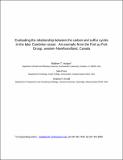| dc.contributor.author | Hurtgen, Matthew T. | |
| dc.contributor.author | Pruss, Sara B. | |
| dc.contributor.author | Knoll, Andrew Herbert | |
| dc.date.accessioned | 2010-04-22T14:43:10Z | |
| dc.date.issued | 2009 | |
| dc.identifier.citation | Hurtgen, Matthew T., Sara B. Pruss, and Andrew Herbert Knoll. 2009. Evaluating the relationship between the carbon and sulfur cycles in the later Cambrian ocean: An example from the Port au Port Group, western Newfoundland, Canada. Earth and Planetary Science Letters 281(3-4): 288-297. | en_US |
| dc.identifier.issn | 0012-821X | en_US |
| dc.identifier.uri | http://nrs.harvard.edu/urn-3:HUL.InstRepos:3988784 | |
| dc.description.abstract | We present a high-resolution δ34S (sulfate and pyrite) and δ13Ccarbonate record from the Middle–Upper Cambrian Port au Port Group, a mixed carbonate-siliciclastic succession exposed in western Newfoundland, Canada. The results illustrate systematic δ34Ssulfate shifts of > 15‰ over relatively short stratigraphic intervals (10 m, likely < 1 m.y.), low average Δ34Ssulfate–pyrite (ca. 23‰) and a generally positive coupling between changes in δ13Ccarbonate and δ34Ssulfate. Together, these results indicate that Middle to Late Cambrian sulfate concentrations were low and that the sulfate reservoir was more sensitive to change than it was in either terminal Neoproterozoic or Cenozoic oceans. However, a simple carbon (C) and sulfur (S) isotope box model of the Late Cambrian ocean illustrates that low sulfate concentrations alone fail to account for the > 15‰ δ34Ssulfate shifts recognized in Port au Port strata. Such large shifts can be generated only if fluctuating oceanic redox is invoked; marine anoxia forces reduced C/S burial and elevated Δ34S, driving larger δ34S changes per mole of organic carbon buried. The conclusion that later Cambrian oceans featured both low sulfate levels and widespread subsurface anoxia supports hypotheses that link fluctuating marine redox conditions in the delayed recovery of skeletal animals and metazoan reefs from late Early Cambrian extinction. | en_US |
| dc.description.sponsorship | Organismic and Evolutionary Biology | en_US |
| dc.language.iso | en_US | en_US |
| dc.publisher | Elsevier | en_US |
| dc.relation.isversionof | doi:10.1016/j.epsl.2009.02.033 | en_US |
| dash.license | OAP | |
| dc.subject | Cambrian | en_US |
| dc.subject | sulfate | en_US |
| dc.subject | anoxic | en_US |
| dc.subject | sulfur isotopes | en_US |
| dc.subject | Newfoundland | en_US |
| dc.subject | SPICE | en_US |
| dc.title | Evaluating the Relationship Between the Carbon and Sulfur Cycles in the Later Cambrian Ocean: An Example from the Port au Port Group, Western Newfoundland, Canada | en_US |
| dc.type | Journal Article | en_US |
| dc.description.version | Accepted Manuscript | en_US |
| dc.relation.journal | Earth and Planetary Science Letters | en_US |
| dash.depositing.author | Knoll, Andrew Herbert | |
| dc.date.available | 2010-04-22T14:43:10Z | |
| dc.identifier.doi | 10.1016/j.epsl.2009.02.033 | * |
| dash.contributor.affiliated | Knoll, Andrew | |


